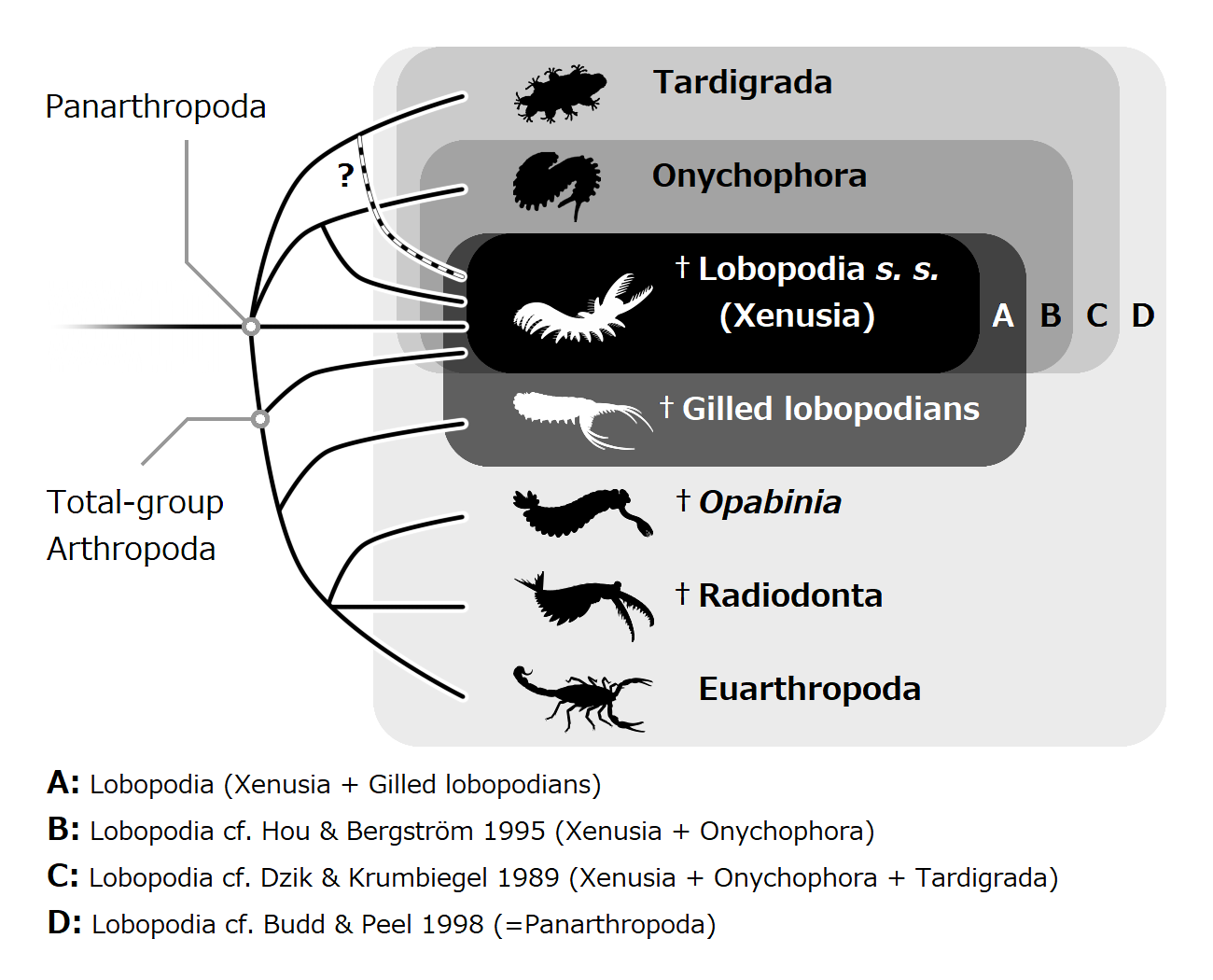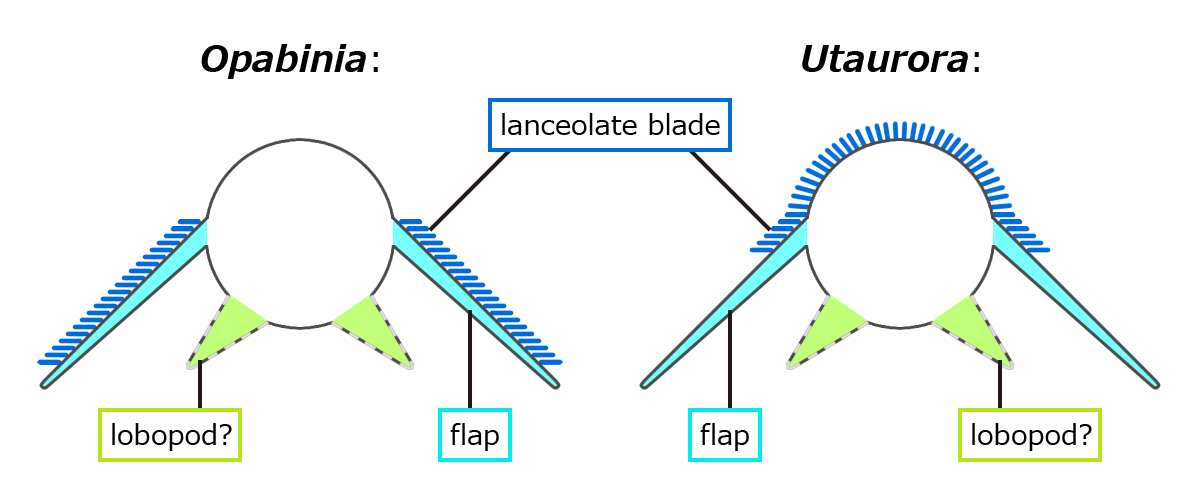|
Omnidens
''Omnidens'', meaning "all-tooth", is an extinct genus of large Cambrian animal known only from a series of large mouth apparatus and sclerotized talon-like structures, originally mistaken as the mouthparts of anomalocaridids. When first named, it was interpreted as a giant priapulid, but is now considered a panarthropod. Its mouth apparatus closely resembles that of the smaller gilled lobopodian ''Pambdelurion'', indicating it is likely to have been a close relative of that species, potentially even synonymous. With a maximum estimated body length of , ''Omnidens'' is suggested to have been the largest known free-living Cambrian organism. ''Omnidens'' fossils are found in the Maotianshan Shales in the Yunnan Province of southern China, and are especially abundant from the slightly younger Xiaoshiba Lagerstätte locality. History The first-described specimen of ''Omnidens'' was first described in 1994. At the time, it was interpreted as the oral cone of an anomalocaridid, and it ... [...More Info...] [...Related Items...] OR: [Wikipedia] [Google] [Baidu] |
Lobopodia
Lobopodians are members of the informal group Lobopodia (), or the formally erected phylum Lobopoda Cavalier-Smith (1998). They are panarthropods with stubby legs called lobopods, a term which may also be used as a common name of this group as well. While the definition of lobopodians may differ between literatures, it usually refers to a group of soft-bodied, marine worm-like fossil panarthropods such as '' Aysheaia'' and '' Hallucigenia''. However, other genera like '' Kerygmachela'' and '' Pambdelurion'' (which have features similar to other groups) are often referred to as “gilled lobopodians”. The oldest near-complete fossil lobopodians date to the Lower Cambrian; some are also known from Ordovician, Silurian and Carboniferous Lagerstätten. Some bear toughened claws, plates or spines, which are commonly preserved as carbonaceous or mineralized microfossils in Cambrian strata. The grouping is considered to be paraphyletic, as the three living panarthropod groups (A ... [...More Info...] [...Related Items...] OR: [Wikipedia] [Google] [Baidu] |
Pambdelurion
''Pambdelurion'' is an extinct genus of Panarthropoda, panarthropod from the Cambrian aged Sirius Passet site in northern Greenland. Like the morphologically similar ''Kerygmachela'' from the same locality, ''Pambdelurion'' is thought to be closely related to arthropods, combining characteristics of "lobopodians" with those of primitive arthropods. Description ''Pambdelurion'' was large for a Cambrian animal, and is estimated to have reached a length of . ''Omnidens'', an organism from China that closely resembles ''Pambdelurion'' and may even be synonymous with it, reached even larger sizes, estimated to be based on the proportions of ''Pambdelurion''. The head of ''Pambdelurion'' bore a large pair of frontal appendages, homologous to the antennae of onychophorans and frontal appendages of Radiodonta, radiodonts. These frontal appendages were weakly muscled and relatively soft, suggesting they may have served primarily as sensory organs, rather than for grasping prey. Between ... [...More Info...] [...Related Items...] OR: [Wikipedia] [Google] [Baidu] |
Lobopodian
Lobopodians are members of the informal group Lobopodia (), or the formally erected phylum Lobopoda Cavalier-Smith (1998). They are panarthropods with stubby legs called lobopods, a term which may also be used as a common name of this group as well. While the definition of lobopodians may differ between literatures, it usually refers to a group of soft-bodied, marine worm-like fossil panarthropods such as ''Aysheaia'' and ''Hallucigenia''. However, other genera like ''Kerygmachela'' and ''Pambdelurion'' (which have features similar to other groups) are often referred to as “gilled lobopodians”. The oldest near-complete fossil lobopodians date to the Lower Cambrian; some are also known from Ordovician, Silurian and Carboniferous Lagerstätten. Some bear toughened claws, plates or spines, which are commonly preserved as small carbonaceous fossil, carbonaceous or Small Shelly Fossils, mineralized microfossils in Cambrian strata. The grouping is considered to be paraphyletic, as ... [...More Info...] [...Related Items...] OR: [Wikipedia] [Google] [Baidu] |
Mobulavermis
''Mobulavermis'' () (meaning "Mobula worm") is an extinct genus of Cambrian kerygmachelid lobopodian from the Pioche Shale, the Combined Metals Member of the Pioche Formation in Nevada; USA. The type species is ''M. adustus'', known from the holotype and paratype. Etymology The generic name, ''Mobulavermis'', comes from ''Mobula'', the genus name of extant manta rays and devil rays. This draws comparison to the elongate flexible caudal spines and broad swimming flaps of ''Mobula'' rays, which resemble the outline of the new taxon. This is combined with the Latin 'vermis', which translates to "worm". The specific name, ''adustus'', is a Latin word which can mean "burnt", "singed", or "sun-burnt". This is in reference to the dramatic yellow, red, and black coloration of the two known specimens, and to the arid conditions of the type locality. Description ''Mobulavermis'' is known from two specimens which were described by McCall, (2023). The intact posterior region of t ... [...More Info...] [...Related Items...] OR: [Wikipedia] [Google] [Baidu] |
Parapeytoia
''Parapeytoia'' is a genus of Cambrian arthropod. The type and only described species is ''Parapeytoia yunnanensis'', which lived over 518 million years ago (Cambrian Stage 3) in the Maotianshan shales of Yunnan, China. Unidentified fossils from the same genus have also been discovered from the nearby Wulongqing Formation ( Cambrian Stage 4). Classification Initially, ''Parapeytoia'' was interpreted as a radiodont ("anomalocaridid" at that time) dinocaridid with legs alongside '' Cucumericrus'', purported to be an indicator that radiodonts might have legs underneath their body flaps in general, comparable to '' Pambdelurion''. With the combination of megacheiran and presumably radiodont features (see text), it was also suggested to be an intermediate form between the two taxa. However, later studies revealed it was most likely nested within megacheira, and the group as a whole was no longer thought to have originated from radiodonts. Within megacheira, ''Parapeytoia'' was po ... [...More Info...] [...Related Items...] OR: [Wikipedia] [Google] [Baidu] |
Cambrian
The Cambrian ( ) is the first geological period of the Paleozoic Era, and the Phanerozoic Eon. The Cambrian lasted 51.95 million years from the end of the preceding Ediacaran period 538.8 Ma (million years ago) to the beginning of the Ordovician Period 486.85 Ma. Most of the continents lay in the southern hemisphere surrounded by the vast Panthalassa Ocean. The assembly of Gondwana during the Ediacaran and early Cambrian led to the development of new convergent plate boundaries and continental-margin arc magmatism along its margins that helped drive up global temperatures. Laurentia lay across the equator, separated from Gondwana by the opening Iapetus Ocean. The Cambrian marked a profound change in life on Earth; prior to the Period, the majority of living organisms were small, unicellular and poorly preserved. Complex, multicellular organisms gradually became more common during the Ediacaran, but it was not until the Cambrian that fossil diversity seems to rapidly ... [...More Info...] [...Related Items...] OR: [Wikipedia] [Google] [Baidu] |
Kerygmachela
''Kerygmachela kierkegaardi'' is a Kerygmachelidae, kerygmachelid Lobopodia#Gilled lobopodians, gilled lobopodian from the Cambrian Stage 3 aged Sirius Passet Lagerstätte in northern Greenland. Its anatomy strongly suggests that it, along with its relative ''Pambdelurion whittingtoni'', was a close relative of radiodont (''Anomalocaris'' and relatives) and euarthropods. The Generic name (biology), generic name "''Kerygmachela''" derives from the Greek language, Greek words ''Kerygma'' (proclamation) and ''Chela'' (claw), in reference to the flamboyant frontal appendages. The Specific name (zoology), specific name, "''kierkegaardi''" honors Denmark, Danish philosopher Søren Kierkegaard. Morphology The head of ''Kerygmachela'' possesses a pair of well-developed frontal appendages which correspond to those of other Dinocaridida, dinocaridids and Lobopodia#Siberion and similar taxa, siberiid lobopodians. Each of them terminates in a series of long spines. A pair of sessile, sli ... [...More Info...] [...Related Items...] OR: [Wikipedia] [Google] [Baidu] |
Kerygmachelidae
Kerygmachelidae is a family of gilled lobopodians (stem-arthropods with flapping trunk appendages and radial mouths) from the Cambrian period. Currently three genera are included in the family: ''Kerygmachela'' from the lower Cambrian of Greenland, '' Utahnax'' from the middle Cambrian of Utah, and '' Mobulavermis'' from the lower-middle Cambrian of Nevada. These animals are characterized by well developed frontal appendages similar to other dinocaridids like the radiodonts Radiodonta is an extinct order of stem-group arthropods that was successful worldwide during the Cambrian period. Radiodonts are distinguished by their distinctive frontal appendages, which are morphologically diverse and were used for a variety ..., except the ones present in these genera are horizontal to one another, and do not curve downward. These animals were most likely nektonic predators, using their large trunk flaps to swim in the water column, and using their frontal appendages to grab small-siz ... [...More Info...] [...Related Items...] OR: [Wikipedia] [Google] [Baidu] |
Utahnax
''Utahnax'' is a genus of kerygmachelid lobopodian from the Drumian of Utah, containing one species, ''Utahnax vannieri'', either from the Marjum or Wheeler formation. Description ''Utahnaxs preserved section is roughly long, with at least eight pairs of ventral flaps similar to those found on ''Kerygmachela''. Unusually, it does not appear to have had legs, suggesting the ventral flaps are broadened lobopods similar to the ventral flaps on radiodonts, and casting doubt on whether ''Kerygmachela'' had legs or whether reported “lobopods” are actually muscles of the flaps. In addition, it may have borne complex digestive glands similar to those of radiodonts. Ecology As ''Utahnax'' nests firmly within the predatory clade of “gilled lobopodians”, it can be assumed that it was also predatory. Its lack of lobopods also suggests it was primarily if not wholly pelagic, occupying a similar niche to radiodonts. This may explain the paucity of gilled lobopodians in the f ... [...More Info...] [...Related Items...] OR: [Wikipedia] [Google] [Baidu] |
Caryosyntrips
''Caryosyntrips'' (" nutcracker") is an extinct genus of stem-arthropod which known from Canada, United States and Spain during the middle Cambrian. It was first named by Allison C. Daley and Graham E. Budd in 2010, being the type species ''Caryosyntrips serratus''. Etymology The scientific name ''Caryosyntrips'' comes from Greek karyon, "nut"; and syntrips, "the smasher", a spirit from Greek mythology. Occurrence Multiple species had been recovered from the Burgess Shale Formation, Canada, Wheeler Shale and Marjum Formation, United States, and Valdemiedes Formation, Spain. The latter contain a large specimen, which was initially misidentified as a body remain of lobopodian ("''Mureropodia apae''"). While the assignment of “Mureropodia” as a misidentified appendage was controversial, the previous lobopodian affinity was less tenable than the fossil being a ''Caryosyntrips'' appendage. Description File:Pates & Daley 2017 f03.png, Fossil frontal appendages of ''C. ... [...More Info...] [...Related Items...] OR: [Wikipedia] [Google] [Baidu] |
Opabiniidae
Opabiniidae is an extinct family of marine stem-arthropods. Its type and best-known genus is ''Opabinia''. It also contains ''Utaurora, and Mieridduryn''. Opabiniids closely resemble radiodonts, but their frontal appendages were basally fused into a proboscis. Opabiniids also distinguishable from radiodonts by setal blades covering at least part of the body flaps and serrated caudal rami. History of study Opabiniidae was named by Charles Doolittle Walcott in 1912, alongside its type species ''Opabinia''. Walcott interpreted Opabiniidae as a family of anostracan crustaceans, most closely related to Thamnocephalidae. ''Opabinia'' was restudied in the 1970s, and reinterpreted as a stranger animal. Stephen Jay Gould referred to ''Opabinia'' as a "weird wonder", and an illustration of ''Opabinia'' prompted laughter when it was first revealed at a paleontological conference. In 2022, more opabiniids were discovered. That being ''Utaurora'', and '' Mieridduryn''. '' Myoscolex'' f ... [...More Info...] [...Related Items...] OR: [Wikipedia] [Google] [Baidu] |
Panarthropoda
Panarthropoda is a clade comprising the greatest diversity of animal groups. It contains the extant phyla Arthropoda (Euarthropoda), Tardigrada (water bears) and Onychophora (velvet worms), although the precise relationships among these remained uncertain according to studies published in 2023 and 2024. Panarthropods also include extinct marine legged worms known as lobopodians (" Lobopodia"), a paraphyletic group where the last common ancestor and basal members ( stem-group) of each extant panarthropod phylum are thought to have risen. However the term "Lobopodia" is sometimes expanded to include tardigrades and onychophorans as well. Common characteristics of the Panarthropoda include a segmented body, paired ladder-like ventral nervous system, and the presence of paired appendages correlated with body segments. Taxonomy Not all studies support the monophyly of Panarthropoda, but most do, including neuroanatomical, phylogenomic and palaeontological studies. At l ... [...More Info...] [...Related Items...] OR: [Wikipedia] [Google] [Baidu] |








